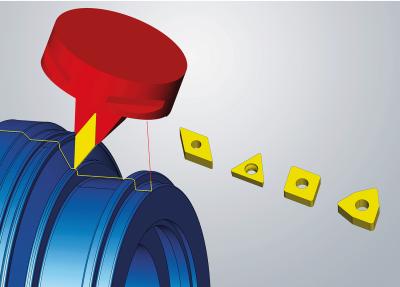
OPEN MIND Technologies AG, a leading developer of CAD/CAM software solutions worldwide, has introduced its latest hyperMILL® 2020.2 CAD/CAM software suite which offers users new and enhanced features for efficient 3D and 5-axis machining, such as the hyperMILL® AUTOMATION Center Advanced option and more.
New features include the addition of plunge-milling cycles to the 3D and 5-axis strategies for machining cutting edges. Material is removed by plunging movements to reduce vibration and improve surface finish, especially helpful for machining edges with steep walls. When 5-axis machining, undercut areas can also be reached by specifying the lateral inclination on the tilted tool. By specifying a distance, circular or linear movement profile, the tool is optimally retracted from the part.
Due to an enhanced mirror path function, users have shorter calculation times and improved process reliability. The mirror path function now enables simple mirroring of previously calculated toolpaths so the machining direction is also mirrored to effectively make climb milling a conventional milling process. hyperMILL® also retains the original strong mirror function where toolpaths for symmetrical components are recalculated on the basis of mirrored geometry data.
"We continue to improve the hyperMILL® user experience with new, optimized strategies, as well as provide easier to use interfaces and even more efficient filtering and feature management functions," said Mr. Alan Levine, Managing Director of OPEN MIND Technologies USA, Inc. "Also, enhanced functionality in our Mill-Turn, hyperCAD® -S and AUTOMATION Center modules are all key to continually improving the user experience and increasing machining productivity."
When 3-axis simultaneous mill/ turning, inserts including round, rhombic, T, and W can now be used. Also, unlocking the potential to reach particularly difficult areas, a new function controls the approach and retract movements by applying user-defined curves for turning strategies.
A hyperMILL® AUTOMATION Center Advanced option offers numerous additional features and extensive templates to the software's automation capabilities. Templates allow the user to define and standardize complex processes independent of the specific geometry from any one CAD model. All the individual steps for data preparation and programming are defined for applying them to a new model and automatically executing them. For exceptional efficiency, the user is interactively guided through the automated process steps, and can be prompted to make relevant choices during the automation sequence if desired.
Components can now be modeled parametrically directly in hyperCAD® -S, especially helpful for fast, production-related designs. Parametric geometry data used in hyperMILL® is associatively linked, and when there are any changes, is automatically updated.
Contact Details
Related Glossary Terms
- climb milling ( down milling)
climb milling ( down milling)
Rotation of a milling tool in the same direction as the feed at the point of contact. Chips are cut to maximum thickness at the initial engagement of the cutter’s teeth with the workpiece and decrease in thickness at the end of engagement. See conventional milling.
- computer-aided design ( CAD)
computer-aided design ( CAD)
Product-design functions performed with the help of computers and special software.
- conventional milling ( up milling)
conventional milling ( up milling)
Cutter rotation is opposite that of the feed at the point of contact. Chips are cut at minimal thickness at the initial engagement of the cutter’s teeth with the workpiece and increase to a maximum thickness at the end of engagement. See climb milling.
- gang cutting ( milling)
gang cutting ( milling)
Machining with several cutters mounted on a single arbor, generally for simultaneous cutting.
- milling
milling
Machining operation in which metal or other material is removed by applying power to a rotating cutter. In vertical milling, the cutting tool is mounted vertically on the spindle. In horizontal milling, the cutting tool is mounted horizontally, either directly on the spindle or on an arbor. Horizontal milling is further broken down into conventional milling, where the cutter rotates opposite the direction of feed, or “up” into the workpiece; and climb milling, where the cutter rotates in the direction of feed, or “down” into the workpiece. Milling operations include plane or surface milling, endmilling, facemilling, angle milling, form milling and profiling.
- turning
turning
Workpiece is held in a chuck, mounted on a face plate or secured between centers and rotated while a cutting tool, normally a single-point tool, is fed into it along its periphery or across its end or face. Takes the form of straight turning (cutting along the periphery of the workpiece); taper turning (creating a taper); step turning (turning different-size diameters on the same work); chamfering (beveling an edge or shoulder); facing (cutting on an end); turning threads (usually external but can be internal); roughing (high-volume metal removal); and finishing (final light cuts). Performed on lathes, turning centers, chucking machines, automatic screw machines and similar machines.
- undercut
undercut
In numerical-control applications, a cut shorter than the programmed cut resulting after a command change in direction. Also a condition in generated gear teeth when any part of the fillet curve lies inside of a line drawn tangent to the working profile at its point of juncture with the fillet. Undercut may be deliberately introduced to facilitate finishing operations, as in preshaving.

